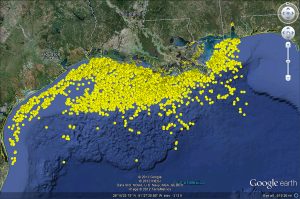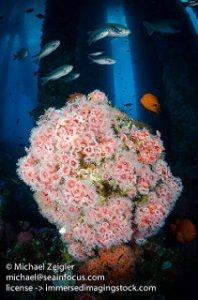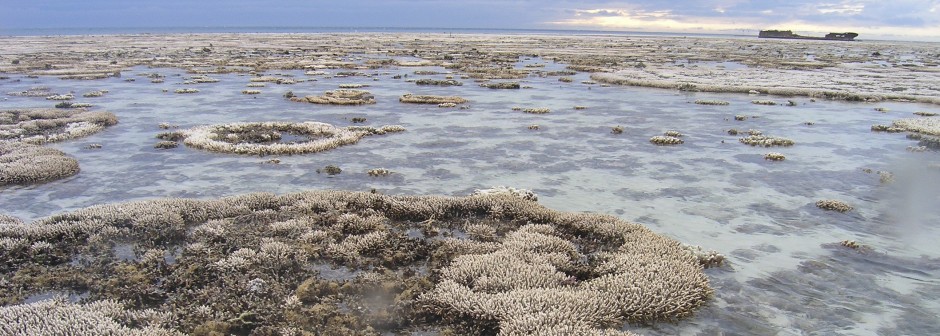In my last post, I discussed a deeply worrying situation that unfolded last year in the East Flower Garden Banks. Thankfully, last year’s bleaching event appears to have been resolved, and the reef is now in recovery. Scientists looking to survey the extent of the damage looked not only at the East Banks, but also in the surrounding areas for any evidence that the bleaching had been spreading. One detail that really caught my attention was that these researchers checked both the West and Stetson Banks, but also on the legs of oil platforms in the area. This got me thinking: are corals often found growing on the legs of oil platforms? As the state of coral reefs around the world continues to worsen from year to year, conservation biologists are exploring a variety of different ways we might be able to reverse this negative trend. One of these solutions involves building artificial reefs: laying man-made reef framework down and then transplanting corals, bypassing the very slow process by which this would naturally occur. The focus of this blog post will be on how the numerous oil platforms scattered across the Gulf of Mexico might play a role in conserving and expanding corals in that region.

US Gulf of Mexico Oil and Gas Platforms, by Rob Shell. Note how there is already a vast amount of groundwork laid out, just waiting for coral transplantation. (Flickr Creative Commons)
One of the great challenges to coral reef conservation efforts is in funding and manpower. It’s hard to find the space in already limited ecological conservation budgets to implement the reef-saving solutions scientists are proposing. I haven’t heard very much discussion so far that touches on using infrastructure that has already been laid down rather than building up artificial reefs from scratch. There are currently 3,200 oil platforms in the Northern Gulf of Mexico1, with more on the way. These platforms are visualized in the image above. These platforms, firmly anchored down to the seafloor, theoretically provide the perfect antecedent topography that reefs require to initially begin growing. The legs of these oil platforms also span the full length of the zone normally habitable by corals. No money would need to be spent laying anything in place on a large scale, because that work has already been done. This would cut down on costs tremendously. Cooperating with artificial reef building efforts would also provide energy companies with opportunities to show that they are playing their part in improving the environment.
A study by the US Ocean Energy analyzed in depth the different kinds of coral species found on 13 different oil platforms in an elliptical shape around the Flower Garden Banks. The coral species that were observed growing on these platforms are many of the same ones that can be observed at the banks, including Madracis Decactis and Pseudodiploria strigosa1. This indicates that coral larvae from the Flower Garden Banks are carried along ocean currents to ultimately settle on oil platforms. There was a strong correlation between the age of a platform, and the density of coral growth that could be observed there1. This study took mere observation of coral settlement on oil platforms a step further by mounting artificial terra cotta growth racks on the platform legs and observing the rate of natural coral settlement over time. Corals grew very slow on these racks- much slower than even natural processes, likely due to the distance from the Flower Garden Banks1. This makes sense, and therefore these results should not be discouraging. I would like to see a follow-up study where pieces of already developed coral are transplanted onto oil platform legs and then monitored over time.

Strawberry Anemones, by Michael Ziegler. This colorful growth is just one example of how oil platforms can serve as a base for coral growth in the Gulf of Mexico. (Flickr Creative Commons)
If utilizing preexisting oil platforms in the Gulf of Mexico and other parts of the world as antecedent topography upon which corals can be grown turns out to be a viable strategy, we could make huge strides in restoring corals lost to bleaching events. I envision a number of ways this strategy could be implemented, such as bringing recreational divers out to the Flower Garden Banks to sightsee but also aid in coral collection for transplantation to oil platforms. As mentioned earlier, energy companies might jump on the opportunity to appear more ecologically conscious. Platforms, normally an eyesore blemishing otherwise pristine waters, can become museums of aquatic diversity, as pictured above. It is important to note that if climate conditions continue to change worldwide such that our seas become less and less habitable for corals, then this strategy will ultimately fall short. Fortunately, turning oil platforms into artificial reefs could be cost-effective enough to implement simultaneously along with other more long-term oriented solutions.
Sources:
- Sammarco, Paul W. “Corals on oil and gas platforms near the Flower Garden Banks: population characteristics, recruitment, and genetic affinity.”US Dept. of the Interior, Bureau of Ocean Energy Management, Gulf of Mexico OCS Region, New Orleans, LA. OCS Study BOEM 216 (2013): 106.

